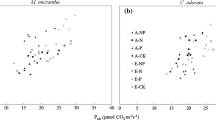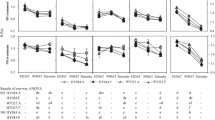Abstract
Rice (a C3 crop) and barnyard grass (Echinochloa crusgalli L.) (a C4 weed) were grown in a 1:1 mixture in a paddy field in ambient condition and with supplemented free air carbon dioxide enrichment (FACE, CO2 concentration + 200 μmol mol−1), in order to evaluate the impact of rising atmospheric carbon dioxide on nutrient competition between rice crop and weed. Results showed that elevated CO2 significantly enhanced the biomass, tillers, leaf area index (LAI) and net assimilation rate (NAR) of rice, but reduced those of barnyard grass after elongation. Tissue nitrogen (N) concentrations were decreased in both competitors, but their phosphorus (P) and potassium (K) concentration were increased. The increase in tissue P concentration of rice was greater than that in barnyard grass. Furthermore, the absolute uptake of C, N, P, K by rice were increased while those of barnyard grass decreased. As a result, significant increase of the ratios of rice/barnyard grass of biomass and absolute nutrient uptake were observed under elevated CO2. The results suggest that rising atmospheric CO2 concentration could alter the competition between rice and barnyard grass in paddy fields in favor of rice. The ability of rice to compete more successfully for nitrogen and phosphorous under elevated CO2 is likely an important factor underlying this response. More generally, the results suggest that elevated CO2 may have varying implications on nutrient dynamics between different elements of overall plant biomass and the soil nutrients pool.


Similar content being viewed by others
References
Ainsworth EA, Long SP (2005) What have we learned from 15 years of free-air CO2 enrichment (FACE)? A meta-analytic review of the responses of photosynthesis, canopy properties and plant production to rising CO2. New Phyto 165:351–372
Alberto MP, Ziska LH, Cervancia CR, Manalo PA (1996) The influence of increasing carbon dioxide and tenperature on competitive interactions between a C3 crop and a C4 weed. Aust J Plant Physiol 23:795–802
Aldrich RJ (1984) Weed-Crop ecology: Principles in weed management, competitiveness of weeds. Wadsworth, California, USA, pp 160–187
Almeida JPF, Lüscher A, Frehner M, Oberson A, Nösberger J (1999) Partitioning of P and the activity of root acid phosphatase in white clover (Trifolium repens L.) are modified by increased atmospheric CO2 and P fertilisation. Plant Soil 210:159–166
Archer J (1988) Crop nutrition and fertilizer use: Grassland and forage crop. Farming press, Ltd. Ipswich, UK, pp 171–185
Caton BP, Cope AE, Mortimer M (2003) Growth traits of diverse rice cultivars under severe competition: implications for screening for competitiveness. Field Crops Res 83:157–172
Chen G, LiaoY CaiSQ, Zeng Q, Zhu JG, Han Y, Liu G, Xu DQ (2002) Leaf photosynthetic acclimation of Echinochloa crusgalli grown in rice field to free-air CO2 enrichment (FACE). Chin J Appl Ecol 13:1201–1204 (in Chinese)
Chen G, Yong ZH, Liao Y, Zhang DY, Chen Y, Zhang HB, Chen J, Zhu JG, Xu DQ (2005) Photosynthetic acclimation in rice leaves to free-air CO2 enrichment related to both ribulose-1, 5-bisphosphate carboxylation limitation and ribulose-1,5-bisphosphate regeneration limitation. Plant Cell Physiol 46(7):1036–1045
Chu CC, Field CB, Mooney HA (1996) Effects of CO2 and nutrient enrichment on tissue quality of two California annuals. Oecologia 107:433–440
Conroy JP, Milham PJ, Barlow EWR (1992) Effect of nitrogen and phosphorus availability on the growth-response of Eucalyptus grandis to high CO2. Plant, Cell Environ 15:843–847
Cotrufo MF, Ineson P, Scott A (1998) Elevated CO2 reduces the nitrogen concentration of plant tissues. Global Change Biol 4:43–54
Edwards EJ, McCaffery S, Evans JR (2006) Phosphorus availability and elevated CO2 affect biological nitrogen fixation and nutrient fluxes in a clover-dominated sward. New Phyto 156:157–167
Fround-Williams RJ (1996) Weeds and climate change: Implications for their ecology and control. Asp Appl Biol 45:187–196
Geiger DR, Conti TR (1983) Relation of Increased Potassium Nutrition to Photosynthesis and Translocation of Carbon. Plant Physiol 71:141–144
Ghannoum O, Caemmerer SV, Ziska LH, Conroy JP (2000) The growth response of C4 plants to rising atmospheric CO2 partial pressure: a reassessment. Plant Cell Environ 23:931–942
Gifford RM, Barrett DJ, Lutze JL (2000) The effects of elevated [CO2] on the C : N and C : P mass ratios of plant tissues. Plant Soil 224:1–14
Graf B, Hill JE (1992) Modeling the competition for light and nitrogen between rice and Echinochloa crus-galli. Agr Syst 40:345–359
Inamura T, Miyagawa S, Singvilay O, Sipaseauth N, Kono Y (2003) Competition between weeds and wet season transplanted paddy rice for nitrogen use, growth and yield in the central and northern regions of Laos. Weed Biol Manag 3:213–221
IPCC (Intergovernmental Panel on Climate Change) (2001) Climate Change 2001: The Scientific Basis. Houghton et al. (eds) Cambridge University Press, Cambridge, pp 225–237
Kim HY, Lieffering M, Kobayashi K, Okada M (2003) Seasonal changes in the effects of elevated CO2 on rice at three levels of nitrogen supply: a free air CO2 enrichment (FACE) experiment. Global Change Biol 9:826–837
Kimball BA, Pinter PJ, Wall GW, Garcia RL, LaMorte RL, Jak PMC, Frumau KFA, Vugts HF (1997) Comparisons of responses of vegetation to elevated carbon dioxide in free-air and open-top chamber facilities. In: Allen LH et al (eds) Advances in carbon dioxide research. American Society of Agronomy, Crop Science Society of America, and Soil Science Society of America, Madison, WI, USA, pp 113–130
Kimball BA, Kobayashi K, Bindi M (2002) Response of agricultural crops to free-air CO2 enrichment. Adv Agron 77:293–368
Kirk RS, Sawyer R (eds) (1981) Pearson’s composition and analysis of foods, 8th edn. Churchill Livingston Ltd, UK
Liu G, Han Y, Zhu JG, Okada M, Nakamura H, Yoshimoto M (2002) Rice–wheat rotational FACE platform I. System structure and control. Chin J Appl Ecol 13:1253–1258 (in Chinese)
Ma HL, Zhu JG, Liu G, Xie ZB, Wang YL, Yang LX, Zeng Q (2007) Availability of soil nitrogen and phosphorus in a typical rice–wheat rotation system under elevated atmospheric [CO2]. Field Crops Res 102:44–51
Mckeehen JD, Smart DJ, Mackowiak CL, Wheeler RM, Nielsen SS (1996) Effect of CO2 levels on nutrient content of lettuce and radish. Adv Space Res 18:85–92
Murphy J, Riley JP (1962) A modified single solution method for the determination of phosphate in natural waters. Anal Chim Acta 27:31–36
Niinemets U, Tenhunen JD, Canta NR, Chaves MM, Faria T, Pereira JS, Reynolds JF (1999) Interactive effects of nitrogen and phosphorus on the acclimation potential of foliage photosynthetic properties of cork oak, Quercus suber, to elevated atmospheric CO2 concentrations. Glob. Change Biol 5:455–470
Oaks A (1994) Efficiency of nitrogen utilization in C3 and C4 cereals. Plant Physiol 106:407–414
Okada M, Lieffering M, Nakamura M, Yoshimoto M, Kim M, Kobayashi K (2001) Free-air CO2 enrichment (FACE) using pure CO2 injection: system description. New Phytol 150:251–260
Pal M, Karthikeyapandian V, Jain V, Srivastava AC, Raj A, Sengupta UK (2004) Biomass production and nutritional levels of berseem (Trifolium alexandrium) grown under elevated CO2. Agri Ecosyst Environ 101:31–38
Patterson DT (1986) Response of soybean (Glycine max) and three C4 grass weeds to CO2 enrichment during drought. Weed Sci 34:203–210
Patterson DT, Flint EP (1990) Implications of increasing carbon dioxide and climate change for plant communities and competition in natural ecosystems. In: Kimball BA (ed) Impact of carbon dioxide, trace gases and climate change on global agriculture. ASA special publication 53. ASA, Madison, WI, pp 83–110
Patterson DT, Flint EP (1995a) Effect of environmental stress on weed/crop interactions. Weed Sci 43:483–490
Patterson DT, Flint EP (1995b) Weeds in climate change. Weed Sci 28:685–701
Patterson DT, Flint EP, Beyers JL (1984) Effects of CO2 enrichment on competiion between a C4 weed and a C3 crop. Weed Sci 32:101–105
Polley HW, Johnson HB, Mayeux HS (1994) Increasing CO2: comparative responses of the C4 grass Schizachyrium and grassland invader Prosopis. Ecology 75:976–988
Reich PB, Oleksyn J, Wright IJ (2009) Leaf phosphorus influences the photosynthesis–nitrogen relation: a cross-biome analysis of 314 species. Oecologia 160:207–212
Staddon PL, Fitter AH, Graves JD (1999) Effect of elevated atmospheric CO2 on mycorrhizal colonization, external mycorrhizal hyphal production and phosphorus inflow in Plantago lanceolata and Trifolium repens in association with the arbuscular mycorrhizal fungus Glomus mosseae. Glob Change Biol 5:347–358
Wary SM, Strain BR (1987) Competition in old-field perennials under CO2 enrichment. Funct Ecol 1:145–149
Yang LX, Huang JY, Yang HJ, Dong GC, Liu G, Zhu JG, Wang YL (2006) Seasonal changes in the effects of free-air CO2 enrichment(FACE) on dry matter production and distribution of rice(Oryza sativa L.). Field Crops Res 98:12–19
Yang LX, Huang JY, Yang HJ, Dong GC, Liu HJ, Liu G, Zhu JG, Wang YL (2007) Seasonal changes in the effects of free-air CO2 enrichment (FACE) on nitrogen uptake and utilization of rice at three levels of nitrogen fertilization. Field Crops Res 100:189–199
Ziska LH (2000) The impact of elevated CO2 on yield loss from a C3 and C4 weed in field-grown soybean. Glob Change Bio 6:899–905
Ziska LH (2003) Evaluation of yield loss in field sorghum from a C3 and C4 weed with increasing CO2. Weed Sci 51:914–918
Acknowledgments
The work was supported by the Projects of National Natural Science Foundation of China (grant no. 30470334, 30770408, 40231003) and the Knowledge Innovation Program of Institute of Soil Science of Chinese Academy of Sciences (grant no. ISSASIP0709). The main instruments and apparatus of the FACE system were supplied by Japan National Institute for Agro-Environmental Sciences (NIAES) and Japan Agricultural Research Center for Tohoku Region (NARCT).
Author information
Authors and Affiliations
Corresponding author
Rights and permissions
About this article
Cite this article
Zeng, Q., Liu, B., Gilna, B. et al. Elevated CO2 effects on nutrient competition between a C3 crop (Oryza sativa L.) and a C4 weed (Echinochloa crusgalli L.). Nutr Cycl Agroecosyst 89, 93–104 (2011). https://doi.org/10.1007/s10705-010-9379-z
Received:
Accepted:
Published:
Issue Date:
DOI: https://doi.org/10.1007/s10705-010-9379-z




